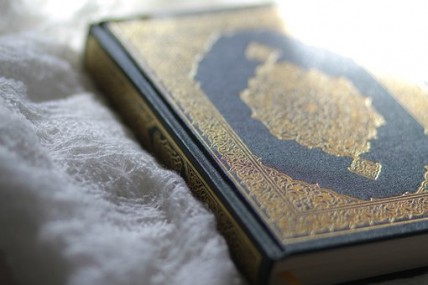The first thing a worshiper does is have the intention and its place is in the heart. We face the Qiblah. If you are leading the prayer or praying alone put a sutra barrier in front of you
Allahu Akbar - Allah is the Greatest
The Takbir of ihram which we commence the prayer it must be pronounced by the tongue. As we make takbir, we raise our hands up to the shoulders with our palms facing the Qiblah or we raise them up to ear level in the same way. After the takbir we put our hands on the chest or below the chest and above the navel or below the navel. All of this is correct.
We place the right hand upon the left hand or we grip the back of the left hand with the right hand or we grip the left arm with the right hand
Al-lahumma ba'id baina khataiayia kama ba'adta baina al-mashriqi wa al-maghreb Al-lahumma naqqini min khataiayia kama iunaqqa athaub al-abyad min ad-danas
Al-lahumma agsilni min khataiayia bith-thalji wal ma'i wal barad
We make the opening supplication after the takbir of ihram and before the recitation, other supplications were also reported for opening the prayer and it's sunnah to use the alternately
A'udhu bil-lahi mina-sha shaytaneer rajeem
The opening supplication is followed by seeking refuge from Satan; then, the recitation of Surat Al-Fatihah with tranquility and presence of mind
We recite one verse after another
Aameen!- It is Sunnah to say it whether one is an Imam or behind and Imam, or praying alone
It is not a verse of Surat Al-Fatihah, rather an invocation meaning: oh Allah, answer!
After Al-Fatihah, we recite some verses of the Qur'an, whether a whole Surah or part of one. When we finish the recitation we pause slightly before moving to Rukuwa'
Allahu Akbar- We make takbir to move from standing to Rukuwa'
This is the second place in prayer, where the Prophet (pbuh) used to raise his hands; so, it is sunnah that we raise our hands to the level of the shoulders or ears. We place our hands on our knees parting our fingers as if we are gripping the knees.
We remain still during rukuwa' with our arms not touching our sides and we do not turn our head to either side the back straight not curved and head in line with the back not tilted up or down
Subhana Rabby al- 'azhim -Glory to Allah the Majestic
We repeat this glorification 3 times, which is the minimum of perfection one glorification, fulfills the duty, but we may add if we wish. We may use any form of reported glorification. There are several forms of dhikr that may be said during rukuwa'
Sami Allahu liman hamidah - Allah hears whoever praises Him
We say this as we raise from rukuwa'; whether we are praying alone or as an Imam
We raise our hands to shoulders or ears level, this is the third place in prayer where the hands are raised, then, we stand upright and say:
Rabbana wa laka al-hamd - Our Lord, praise ne to You
Hamdan kathiran, tayyiban mubarakan fih- Praise that is abundant, good and blessed
After raising from rukuwa' we may send our arms down or place them one over the other; it is sunnah to stay standing for a while after rukuwa' and be tranquil
Allahu Akbar -
We then go down to making takbir, to move from standing to prostration. We may place our hands on the floor before our knees or knees before our hands whichever is easier for us. We must prostrate on seven bones, as the Prophet (pbuh) taught us, the forehead with the nose, the two hands, the two knees and the two feet. We keep the feet erect, with the toes pointing to the Qiblah
We keep the thighs apart, not touching the abdomen. We keep the arms raised from the ground and not touching the sides unless we are praying in a congregation and we fear to cause inconvenience to those next to us. Fingers should be attached and to the direction of Qiblah. Our hands should be parallel to the shoulders or ears
Subhana Rabbi al-'Aala - Glory be to my Lord the Most High
We repeat this glorification three times, which is the minimum of perfection; one glorification fulfills the duty but we may add if we wish. We may use any of the reported forms of glorification and, we may supplicate for whatever we wish of the good things of the worldly life and the Hereafter.
The Prophet (pbuh) said: "The closest a person gets to his Lord is when he is on prostration, so, supplicate a lot"
Allahu Akbar-
We make takbir as we lift our head from prostration. We put our left foot flat and sit on it resting well, keeping our right foot upright, with his toes towards the Qiblah, or, we keep both our feet upright and sit on our heels. We stretch our arms, placing the right hand on the right thigh and the left hand on the left thigh closed to the knees or on the knees.
Rabbi igghfir li - My Lord, forgive me
We say this supplication between the two prostrations as we sit tranquilly
Allahu Akbar -
We make takbir as we move down to make the second prostration, which is exactly the same as the first prostration
Allahu Akbar-
We perform the second Ra'kah' exactly as we performed the first Ra'kah', the same position of the hands, recitation of surat Al-Fatihah and some verses of Qur'an; then, we make rukuwa'
Allahu Akbar -
As we raise from rukuwa'
Sami Allahu liman hamidah, Rabbana wa laka al-hamd
Then, we go down to prostration
Allahu Akbar -
We make two prostrations and then sit for the Tashahud
Allahu Akbar -
Allahu Akbar -
Allahu Akbar -
After completing the second raka'ah' we sit for the tashahood in the iftarash posture; keeping the left foot flat on the ground and sitting on it while the right foot is kept upright. We sit in the eftarash posture in the tashahood of any two raka'ah' prayer; such as, Friday, Fajer and the two Eid prayers
As well as the first tashahood of three raka'ats and four raka'ats prayers and also when we sit between the two prostrations. If someone cannot sit in this way because he has a big body or suffers from foot pain or for any reason, he may sit in any way he can
When we sit for tashahood we place the right hand on the right thigh with all the fingers drawn in except the index finger to point with or, we make a circle with the thumb and the middle finger, pointing with the index finger. As for the left hand, we either place it flat on the left thigh or join it together over the knee.
During tashahood it is recommended to keep looking at the index finger of the right hand
At-tahiyyiatu lillahi wa salawatu wa at- tayyibatu as-salamu 'aleika ayyiuha an-nabiyyu wa rahmatullahi wa barakatuh; As-salamu 'alayna wa 'ala 'ibadillah as-salihin
Ashhadu an la ilaha illa Allah wa ashhadu anna Muhammadan 'abduhu wa rasuluh
We read only this first part of the tashahood when it is three raka'at or four raka'at prayer in a two raka'at prayer, such as, fajer, Friday or Eid prayers. We complete the tashahood by reading the ibrahamic invocation
Allahumma salli 'ala Muhammad wa 'ala aali Muhammad kama sallayta 'ala Ibrahim wa 'ala aali Ibrahim innaka hamidun majid,
Allahumma barik 'ala Muhammad wa 'ala aali Muhammad kama barakta 'ala Ibrahim wa 'ala aali Ibrahim innaka hamidun majid
as salamu 'alaykum wa rahmatullah
as salamu 'alaykum wa rahmatullah
Taslim is said after finishing the tashahood and reciting the supplications reported in the Sunnah. But this applies in the two raka'ah prayers. We hear Allahu Akbar in a low voice in a three raka'ah prayer like maghreb or a four raka'ah prayer like dohor, 'asar and 'isha.
We stand up after the first tashahood to pray one more raka'ah. If we are praying maghreb, or two more raka'ahs if we are praying dohor, 'asr or 'isha; in these raka'ahs we recite al-Fatihah and we do everything we did before in rukuwa', prostration, standing and sitting;
Allahu Akbar -
The Prophet (pbuh) used to sit in a posture called Tawarrook during the last tashahood of every prayer; consisting in two tashahoods.
Sitting in the tawarrook posture is done only in the last tashahood three raka'ah or four raka'ah prayer; it has more than one form, placing the left foot flat on the ground and keeping the right foot upright and letting them both out from the right side; such that both hips are on the ground, or placing both feet flat and letting them out from the right side, or placing the right foot flat and placing the right foot between the thigh and shin of the right leg.
While sitting for the last tashahood we read the tashahood, then follow it with the invocation of peace upon the prophet.
After reciting the full tashahood and before making taslim we seek refuge with Allah from four things: the torment in hellfire, the torment in the grave, the trials of life and death and the evil of the trial of the antichrist. And we supplicate a Allah for whatever we wish of the good things of the worldly life and the hereafter.
The prayer is not completed until Taslim is made. By making taslim we have thus finished our prayer.
When a person makes taslim it is sunnah for him to ask Allah Almighty for forgiveness three times and then recite the dhikr reported from the Prophet, peace be upon him,
Abu Huraira reported: I heard the Prophet (pbuh) say:
'the first thing of a person's deeds that he will be held to account for on the Day of Judgment is his prayer if it is good he will succeed and win and if it is bad he will fail and lose'


